Sooner or later, the moment comes when the Energosbyt inspector gives you an order to replace the old electric meter with a new one or install the meter on a newly built structure (house, garage, shop). The prescription will indicate the brand and section input cable, rated current introductory and, accordingly, the meter itself, which you have to choose yourself in the electrical goods store. I advise, of course, to seek help from an experienced electrician, but if you yourself want to understand the types of electric meters and the requirements for them, then you will learn everything you need in this article.
Single-phase or three-phase electricity meter?
You can find out for which voltage class 220 V or 380 V you need to buy an electric meter using the old one, if you change it and the plate indicates 230 V (single-phase) or 230/400 V (three-phase). In private houses, you can determine the number of phases of the mains by the number of wires connected to the input: two wires - single-phase network, four wires - three-phase. And lastly, a three-phase meter has 11 connection terminals, and a single-phase meter has 4!
Selection by maximum load current.
As a rule, the maximum load current can be found from the input current circuit breaker installed before the counter (rated current is indicated as C25, C32, etc.). After that, an electric meter is selected with a larger current strength than that of the machine. The rated current of a single-phase meter is 5-60 A, for a three-phase meter up to 100 A inclusive.
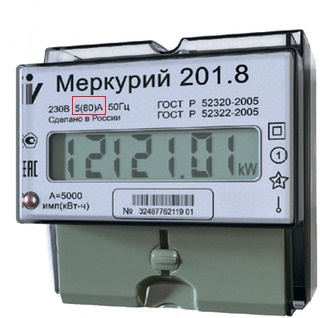
Accuracy class.
Like any measuring device, the electric meter has its own accuracy class - error, inaccuracy when metering electricity. According to the EIC, clause 1.5.15. accuracy class of settlement meters (single-phase and three-phase) installed in residential buildings, garages, etc. must not exceed 2; for legal entities no more than 1. Also, meters are produced with an accuracy class of 0.5, 0.5s and 0.2.
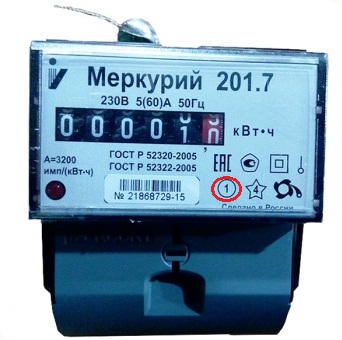
Mounting method in shields.
Manufacturers produce meters with three-bolt or DIN-rail mounting. Therefore, when choosing a meter, it is necessary to immediately select a shield of the appropriate size so that it contains both the meter itself and the necessary protection devices. In addition, the electrical switchboard must have a window at the level of the meter dial for taking readings and be installed at a height of 0.8-1.7 m from the floor level in an easily accessible place.
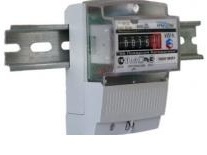
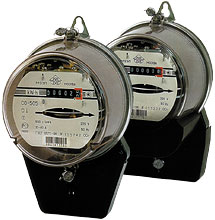
Induction or electronic?
From previous articles, you learned about the design of induction and electronic meters. When buying one of the following, you need to be guided by their advantages and disadvantages. As for the induction meter, it is reliable in operation, resistant to surges, has a long service life and low cost. The disadvantages include electricity metering at one tariff, the possibility of electricity theft, low accuracy class (not lower than 2), additional internal electricity consumption.
The advantages of an electronic electricity meter are: multi-tariff, high accuracy class, measurement of various network parameters, protection against theft of electricity, calibration interval every 10-16 years, small overall dimensions, etc. Disadvantages: high cost, not maintainable, very sensitive to the quality of electricity.
Single-tariff or multi-tariff meter?
A multi-tariff meter is installed in order to save money when paying for electricity, where the cost of 1 kWh at night is cheaper than during the day. By order of the Federal Tariff Service dated November 26, 2013 No. 1473, Moscow is established for two-tariff meters time of the day tariff from 7.00 am to 11.00 pm, night time from 23.00 am to 7.00 am; for a multi-tariff or three-tariff, the night zone is also from 23.00 to 7.00, the peak zone is from 7.00 to 10.00 and from 17.00 to 21.00, the rest of the time the semi-peak zone is in effect. Daytime tariffs of multi-tariff meters are higher in cost than single-rate meters, although nightly rates are about 50% cheaper than both. Therefore, it is beneficial to use multi-tariff meters when the highest electricity consumption is predominantly at night.
If you have sufficiently powerful electrical consumers in your house, such as an electric boiler, electric water heater, electric stove, etc., then you need to provide the technical passports of electrical appliances and other Required documents. As a result, Energosbyt will reduce the cost of 1 kWh for the day and night zones, which will also save you money.
Date of manufacture of the electric meter.
When buying a counter, you should pay special attention to the date of issue of the counter, which is indicated in the passport and on the dial. On newly installed single-phase meters, the screws securing the electric meter casing must have seals with a stamp of state verification with a limitation period of no more than 2 years, and for three-phase meters no more than 12 months. If the verification period of the new meter has expired, then the inspector of the power supply company will require you to carry out state verification at your own expense, which in monetary terms is approximately equal to the cost of a new meter! After the inspector accepts the meter “in accordance with all the rules”, he will be given a seal by the energy supply organization on the clamp cover, which is not recommended to be torn off and can be regarded as theft of electricity. If you want to install a previously used meter, then I recommend that you consult again with the inspector of the electricity supply company!
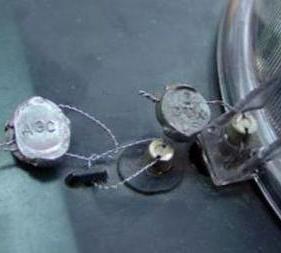
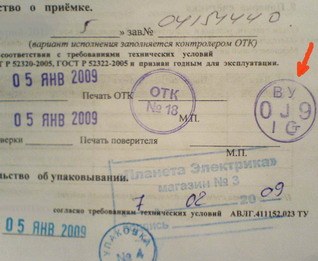
I wish you good luck when choosing an electric meter based on the above criteria!
Today it is rare to find a residential building in which there is no installed counter for electricity, since almost everywhere devices and equipment powered by electrical network. During installation work with wiring or during its reconstruction, it is necessary to replace old devices with newer, more accurate ones. In order to choose the right device for monitoring power supply, you should know what types of devices are, what parameters they have, as well as a number of features.
The electricity meter is a common device for monitoring the electricity consumed by the user. The reliability of the accounting system directly depends on right choice such equipment. To do this, you need to choose the appropriate type of device design for the corresponding electrical network. Thus, you can purchase an electricity meter for single-phase wiring and three-phase.
Specifications
When choosing an electricity meter, the buyer should be aware that, depending on the principle of operation control equipment, they are divided into two types: induction and electronic. induction devices. This is a mechanical unit in which there are two coils (voltage and current). During operation, a magnetic field is generated that rotates the disk. And the disk, in turn, sets in motion a scale with values for calculating the amount of electricity received.
The speed depends on the voltage level in the network. The higher the power, the higher the rotation speed of the disk. Induction meters have counting errors, and increasing the accuracy class is very expensive. Service life is about 15 years. The most common type of construction.
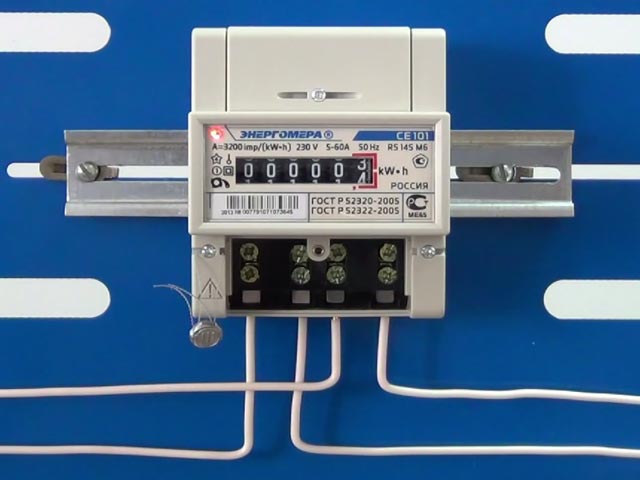
Electronic devices. The operation of such equipment is based on direct measurement of current on the line and voltage. The scale of this counter has an electronic form, and is able to store values in memory. The advantages include small dimensions. The device can carry out maintenance of one- and two-tariff accounting. It can also be integrated into an automated system for commercial electricity metering, thanks to an accessible simple meter interface. Numeric values allow more accurate reading of information. However, they have a shorter warranty period and are not as reliable as induction type devices.
In the passport of a particular model of the electricity meter, all specifications, which it possesses - the permissible temperature during operation, for which type electrical line designed, rated voltage and current, weight, dimensions, connection diagram, service life, accuracy class, as well as other parameters that are relevant to the installation.
Electricity meters are usually calculated for connection separately to a single-phase and three-phase line. This affects the rated current that can flow through the device. So for single-phase meters, the permissible current strength is in the range from 5 to 60 amperes, and for three-phase meters from 50 to 100 amperes with a connection transformer up to 100 A.
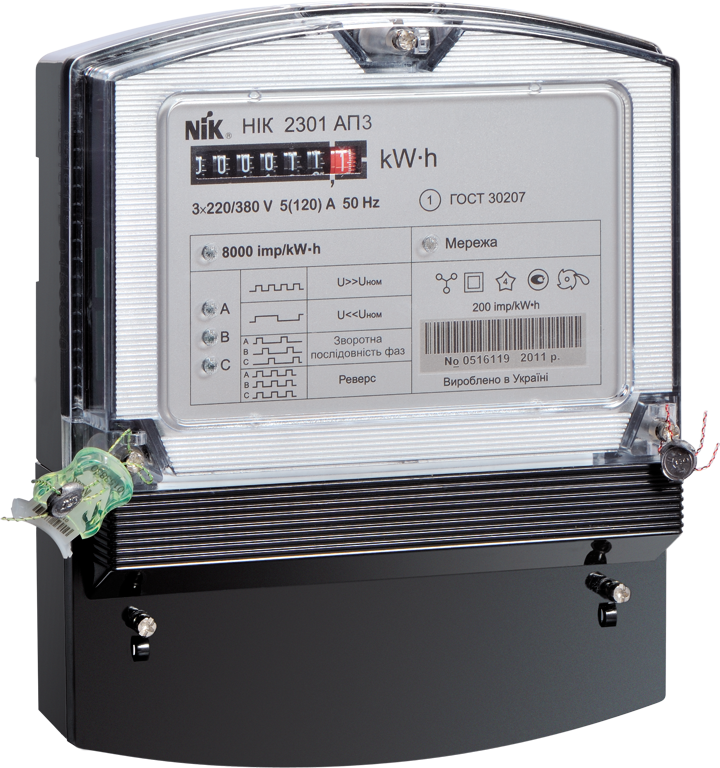
Since a load of 100 A is rare in private residential buildings and high-rise buildings, the installation of transformer three-phase meters is not often done. The rated voltage for single-phase devices is standard 220 volts, and for three-phase lines - 380 volts. When you need to choose an electricity meter for residential consumers, you should independently calculate the total power of all equipment that can be connected at the same time.
On average, this value is up to 5,000 watts. For such power, you need a device with a rating of up to 40 amperes. For the current of a three-phase line, you should also pay attention to their connection diagram. When buying, you need to take into account the technical characteristics that determine the possibility of their operation in certain conditions, all the advantages and disadvantages.
Instrument Selection Options video
Which to choose
At the moment, in the electrical engineering market in the CIS countries, a common model is the electricity meter of the brand Mercury and Energomera. Mercury devices are produced both for a single-phase electrical network and for a three-phase one. A variety of models with various modifications and power allows you to choose a device for any consumer.
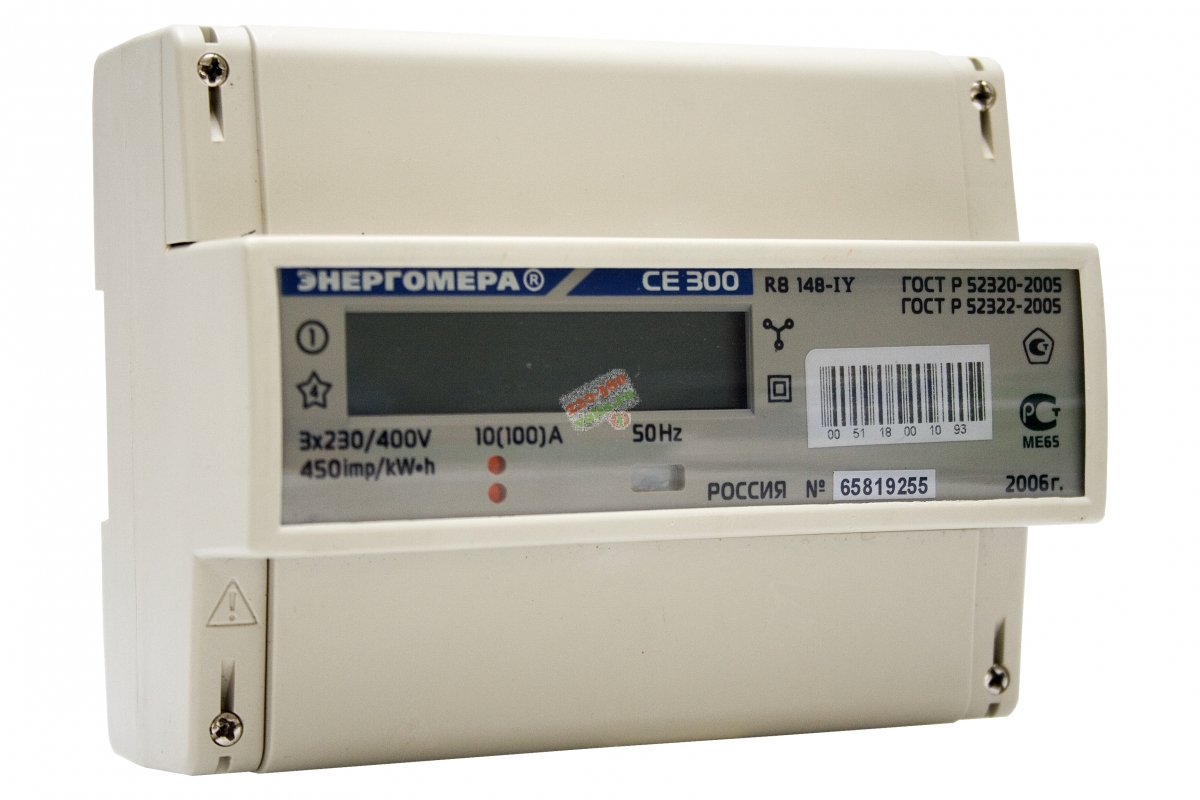
The Mercury counter is manufactured in Russian Federation(Moscow city). It occupies a leading position in the electrical equipment sales market. Due to their reliability and range, Mercury meters began to be used not only in residential premises, but also in industrial buildings and public places. It has a favorable price, unlike similar samples from other manufacturers. All Mercury devices comply with GOST standards.
- Mercury models are produced with one or two rates. The average service life of devices is about 25 years, the warranty is issued for 3 years;
- the Mercury-230 model is intended for three-phase network commercial or technical accounting;
- the Mercury-201 model is connected to a single-phase electrical line and has a simpler design.
Mercury readers are installed on a DIN rail with circuit breakers, occupying 6 modules. Energy meters are reading devices that are also available in various models for their respective purposes. For a three-phase network, an Energomer of the CE300 brand is used. To choose the right reading device, you need to know exactly what characteristics it should have or consult a specialist.
Advantages and disadvantages
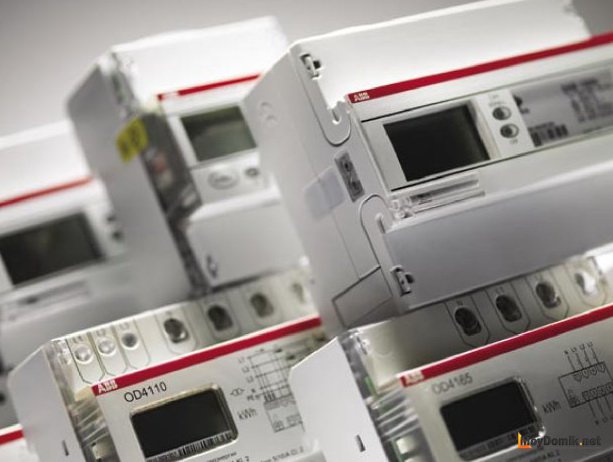
The obvious advantages of electronic meters over induction meters include a wide range of functioning. In addition to the ability to count the electricity passing through the device and display its value on the dial, this type of design can be used to connect to a system for separate metering of electricity consumption at different rates.
Two-tariff and multi-tariff models (for example, Mercury or Energomera) are gradually gaining popularity, which increases their demand. This feature allows you to calculate the cost of a unit of electricity for the consumer in daytime and separately at night. Electronic meters have become in demand among consumers who live in regions with daily tariff zones. The efficiency of their operation at low temperatures does not decrease. So when placing the electricity meter on the street, the accuracy of the readings will not be affected by the air temperature.
Also, the advantages of the electrical device include a higher accuracy class (0.2S and 0.5S) than that of induction reading devices. As well as the stability of these values \u200b\u200bwith temperature changes throughout the entire period of operation. They must work stably on single-phase and three-phase networks.
Today it is difficult to imagine our life without electricity. And since there is electricity, then there must be metering devices that count the amount of electricity consumed in your home. We'll talk about these devices - electric meters.
In stores today there is a large selection of electricity meters. various types Therefore, when buying, it is important to know the basic parameters.
Number of phases
One of the main selection criteria is for which networks the meter is intended: single-phase or three-phase. If in apartments the vast majority of the network is single-phase at 220 V, then in a private house it can be either single-phase or three-phase at 380 V.
Counter type
Electric meters are divided into two types: induction and electronic.
The principle of operation of induction meters is based on the interaction of the magnetic fluxes of two coils: a voltage coil and a current coil, between which there is an aluminum disk.
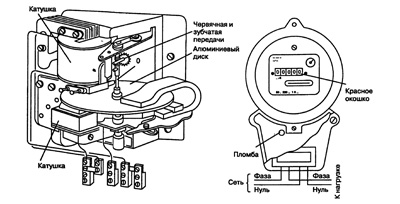
Under the influence of electromagnetic forces, the disk begins to rotate and with the help of worm gear interacts with the counting mechanism. The higher the torque of the disk, the higher the power of the supplied signal, which means that the power consumption will be greater. When the power of the supplied electromagnetic signal decreases, the permanent braking magnet comes into action. It evens out fluctuations in the frequency of rotation of the disk due to interaction with vortex flows. The magnet creates an electromechanical force that is inverse to the torsion of the disc. This causes the drive to slow down or stop altogether.
The advantages of induction meters are their durability, lower cost compared to electronic meters and insensitivity to voltage drops in the network.
The disadvantages of such meters are: low accuracy class, lack of multi-tariff, own energy consumption is greater than that of electronic ones, impressive dimensions, which can be critical if there is not enough space in the electrical panel, at low loads there is more error in readings.
Electronic meters today look more preferable, despite the fact that they are slightly more expensive than induction meters.
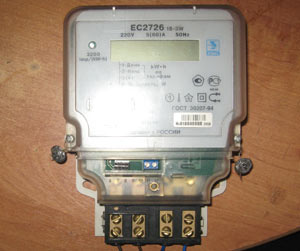
They allow you to account for electricity at several tariffs (single-tariff, two-tariff and multi-tariff), more compact compared to induction, have a high accuracy class, the ability to integrate into the AMR system ( Automated system commercial accounting of electricity), convenient reading of indications from the display.
Among the shortcomings of electronic meters, one can note their high sensitivity to the quality of electricity and a higher price.
Accuracy class
The accuracy class determines the permissible error with which the electric meter measures the consumed electricity.
According to the Decree of the Government of the Russian Federation of 04.05.2012 N 442 “On the functioning of retail markets electrical energy, full and (or) partial restriction of the mode of consumption of electrical energy "accounting for the electrical energy consumed by citizens should be carried out only by meters of accuracy class 2.0 and higher. In the near future, it is planned to transfer all meters to an even higher accuracy class - 1.0. Therefore, when buying a new counter, you should think about it.
Electric meters of accuracy class 2.5 with an expired calibration interval are not verified, but must be replaced.
The accuracy class is displayed on the meter body as a number in a circle.
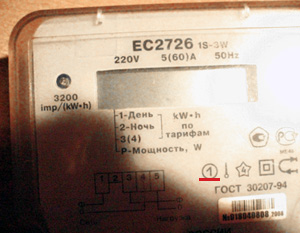
Calibration interval
When buying a new electric meter, be sure to pay attention to the presence of seals with a verification period and the absence of any mechanical damage on them. Please note that the verification year is not set in full, but only the last two digits.
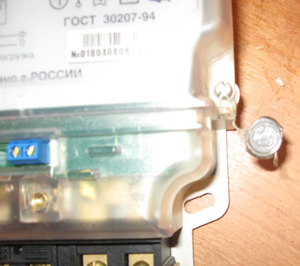
On new single-phase meters, there must be state verification seals with a period of not more than 2 years, and on three-phase meters - no more than a year. The certificate of the device must indicate the calibration interval, which is counted from the year of verification indicated on the seal. The period of verification frequency depends on the manufacturer, type of metering device and is approximately 6-16 years for various models, more precisely, you can find out about this from the passport of the metering device.
Current value
The maximum current of the electric meter depends on the maximum load, the consumption of which it will take into account. To determine the load, it is enough to know the rated current of your introductory machine. For example, if the input is 32A automatic, then a meter with a maximum current value of at least 40A will do. On meters, the current value is usually indicated in this form - 5 (60) A, where 5 is the rated current, 60 is the maximum, it is the value of the maximum current that should be paid attention to.
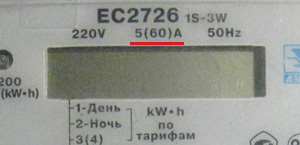
If the load value exceeds 100A, then a transformer connection meter is required.
Single-tariff or multi-tariff meter
Until relatively recently, all household meters were single-tariff, but today everything has changed and you can choose the tariff that suits you best. At the moment, there are single-tariff, two-tariff and multi-tariff electricity meters.
Single-rate meters keep records at a single-rate (single-zone) rate around the clock.
Two-tariff electricity meters record electricity in two tariff zones - day (from 7:00 to 23:00) and night (from 23:00 to 7:00). The intervals of the tariff zones of the day are established by order of the Federal Tariff Service of Russia dated November 26, 2013 No. 1473-e and are defined in astronomical hours according to local time. Since the night tariff is an order of magnitude cheaper than the day one, it becomes possible to reduce your electricity costs, but you need to take into account that the daily tariff with a two-tariff system will be slightly higher than with a one-tariff system.
Multi-tariff meters keep records in three zones: peak zone - from 07.00 to 10.00 and from 17.00 to 21.00, semi-peak - from 10.00 to 17.00 and from 21.00 to 23.00 and night - from 23.00 to 07.00. The highest cost of electricity is in the peak zone, the lowest is in the night zone.
Since tariffs in different regions of the Russian Federation differ significantly from each other, it is difficult to talk about the unconditional benefit of one or another tariff.
For example, I will give electricity tariffs in St. Petersburg:
Categories of consumers |
Tariff rate RUB/kW*h incl. VAT | ||
| One-part tariff | Tariff differentiated by two zones of the day | ||
| daytime (peak and semi-peak) zone | night zone | ||
| 1. The population living in urban areas in houses equipped in the prescribed manner gas stoves | 4,12 | 4,29 | 2,47 |
| 2. The population living in urban areas in houses equipped in the prescribed manner with stationary electric stoves and (or) electric heating installations | 2,88 | 3,00 | 1,73 |
| 3. Consumers equated to the population | 4,12 | 4,29 | 2,47 |
| Categories of consumers | Tariff differentiated by three zones of the day |
||
| day zone | night zone | ||
| peak zone | semi-peak zone | ||
| 1. Population living in urban areas in houses equipped in the prescribed manner with stationary gas stoves (tariffs are inclusive of VAT) | 4,32 | 4,12 | 2,47 |
| 2. Population living in urban areas in houses equipped in the prescribed manner with stationary electric stoves and (or) electric heating installations (tariffs are indicated including VAT) | 3,02 | 2,88 | 1,73 |
| 3. Consumers equated to the population (tariffs are indicated including VAT) | 4,32 | 4,12 | 2,47 |
Counter replacement
Replacing the electricity meter requires permission from the utility company. To do this, you need to call the company and invite their representative to take readings from the old meter and issue permission for a replacement. Having received permission, you can replace the meter yourself, or invite an electrician. Do not forget that unauthorized dismantling of the meter, without agreement, is a violation of the contract and leads to penalties.
After replacement, the meter must be registered. To do this, you will have to call again a representative of the energy sales company, who will seal the meter and give permission for further operation. After that, electricity metering will be carried out in accordance with the readings of the new meter.
Replacement of the electric meter is made at the expense of the consumer.
If you make a mistake, the machine will correct you.
An electric meter is used to account for the consumption of electricity by various groups of consumers (physical and legal entities). Electricity meter readings are the basis for settlements between subscribers and the sales company. There are certain rules that allow you to choose an electric meter, depending on the type of electrical network and operating conditions.
Selection of single-phase electricity meters
Meter billing
One of the main criteria when choosing an electric meter is tariff for electricity bills. Previously, there was only one tariff calculation system, according to which the cost of consumed electricity did not depend on the time of its consumption. In order to equalize consumption peaks and encourage the use of electricity at night, a multi-tariff metering system was developed. In particular, the two-tariff system provides for differentiated payment depending on the time of day. For example, at night for individuals the cost of 1 kW of electricity can be 1.3 rubles, and in the afternoon 2. At the same time, subscribers can use one tariff system, which provides for a single cost of 1.7 rubles per 1 kW.
Using a two-tariff payment system it is possible to achieve a reduction in the cost of paying for electricity by changing the mode of consumption and transferring part of the loads to night time. It should be taken into account that one tariff electric meter has a simpler design compared to the two tariff and, accordingly, is cheaper. The main breakdown of two tariff meters is a malfunction of the liquid crystal display, which displays the data necessary for the calculations.
Rated current of the electric meter
The rated current of the electric meter must comply with electric current at maximum load in the electrical network of your home. This value can be found from the rating of the introductory circuit breaker. Most household electricity meters are designed for networks with a total consumption of up to 15 kW and have a maximum current of 50-60 A. If the total power consumption in the house exceeds 15 kW, then it is recommended to choose a 100 A meter. current of a higher rating than that for which the introductory machine is designed, then the sales company may require its replacement. The presence of an electric meter of a larger rating may raise suspicion about the possible connection of a larger load. In this case, you will have to purchase another electric meter, designed for a lower current.
Fastener type
According to the type of fasteners, electric meters are distinguished, designed for installation in switchboards modular type, with a mounting panel or shields Shchurn. For modular boxes, meters of type SOE 55 or FBU 11205 are used. Meters of type SOE 55 412 are installed on a mounting panel.
Electricity metering systems
The development of electricity metering systems is moving towards automating the collection of data from subscribers to a single center, where they will be processed and analyzed to optimize payments for consumed electricity. In the future, it is possible to create a system that will combine all metering devices, including gas and water meters. At the moment, this program has been partially implemented and some subscribers have already installed meters with an interface for connecting to GSM or PLC modems.
When choosing a new electricity meter, it is worth getting information from the sales company about the prospects for switching to a new metering system. If this happens in the foreseeable future, then it makes sense to purchase a meter with a data interface. Although single-phase meters with an LCD display can last for some more time.
manufacturer specification
You must also contact the sales company in order to choose an electric meter of exactly the series and type that is allowed in your locality. Usually, a list of permitted metering devices and their manufacturers is available on the website of the electricity distribution company. From the available list, you must select the appropriate technical parameters and price model. Often the sales company itself offers its subscribers to purchase an electric meter from them. At this method acquisition has a number of advantages. First of all, you will purchase a high-quality counter without the risk of buying a substandard product or counterfeit. The proposed metering device is approved for use by this company. Often the offered price of the meter is lower than in trading companies due to lower selling prices of the manufacturer's plant.
If we talk about the quality of electricity meters, then it should be borne in mind that the main part of electricity meters used in Russia is made in China. This allows you to reduce the cost of products and offer consumers more favorable prices. Currently most common electricity meters manufactured by ABB, LEMZ, Energomer, INCOTEX, MZEP and Taipit. Some of them (ABB, INCOTEKS, MZEP electric meters) are distinguished by a high degree of reliability and in the event of a malfunction, many companies change them to other meters or return the money. In case of failure of electric meters of other brands, the buyer will have to contact the manufacturer's service department. Information about this is reported to buyers during the sale of metering devices. Trading companies cannot give more complete recommendations on the choice of a specific model due to the lack of a testing laboratory and employees capable of checking the quality of the metering devices being sold.
Can be given general recommendation do not choose the cheapest models, or consult experts from companies specializing in the installation and operation of electricity metering systems. At the same time, there is a possibility that you will be offered a more expensive model, or a model that is not in great demand.
Criteria for choosing three-phase electricity meters
If it is necessary to install a three-phase meter, the choice is significantly limited. As a rule, the type of meter is determined by the sales company, and it is very problematic, and often impossible, to coordinate the installation of another meter. Sometimes they recommend quite expensive electricity meters that have a complex design and additional options that are not used during operation. In particular, the counter Mercury 233 ART 01 ROL costs 9.5 thousand rubles including VAT. At the same time, it has power relays and subscribers, whom the sales company obliged them to purchase, are forced to install and program them.
Before you figure out which electric meter to choose, you need to consider the device of the electric meter and the principle of its operation. We will not go into technical specifications, but we will indicate the defining parameters that you should pay attention to.
Electricity meter selection options
The maximum current for which the meter is designed.
Sometimes the question arises of how to choose an electricity meter by current, the solution is quite simple - read on. Single-phase meters are used mainly for powering apartments, private houses and small office and retail premises. The rated power of such networks is in the range of 3-7 kW (the maximum value is given for apartments with electric furnaces) at a voltage of 220V. Considering that 1 kW of power corresponds to a circuit current approximately equal to 4.5A, we get the current for which the metering device should be designed at 13-32A. The current for which the meter is designed must not be less than the calculated one.
On the front panel of any electric meter, even if you have lost your passport for it, its main characteristics are always indicated, including the rated and maximum current, for example: 5-40A, which means the rated current is 5 amperes, the maximum, respectively, 40.
Electric meter accuracy class
Until July 1, 1997, there was a 2.5 standard for electricity metering. This meant that the accuracy of the electricity meter, namely the measurement of electricity consumption, was 2.5%. After this time, the use of such devices was banned, and a new standard 2.0 was introduced. To install a device with such an error in an apartment is quite enough. Electronic meters are produced with a measurement accuracy of up to 0.5%, which all the more meets modern requirements.
Which electric meter to choose - electronic or induction?
Counter models today - eyes run wide. But it is still better to opt for electronic electricity meters, as they have undeniable advantages over induction, as well as hybrid ones that exist today as a transitional option.
In addition to those already known to us (Energomera, Incotex and MZEP), electronic meters are also manufactured in Russia today by the Nizhny Novgorod Plant named after M.V. Frunze", "Leningrad Electromechanical Plant". The production of meters by these manufacturers accounts for more than 80% of all manufactured electricity meters. For now, we will not consider foreign-made meters due to the difficulties that arise with their repair, if necessary.
Basically, most consumers today are concerned about electricity meters for apartments and houses, as well as small commercial and industrial enterprises.
Electricity meter test data
To date, absolutely all electricity meters included in State Register, according to their metrological characteristics correspond to the current standards. However, sometimes, for the selection of products, a certain country conducts an independent examination of individual samples on the basis of its laboratories.
So, according to the magazine "News of Electrical Engineering" No. 1 (31) and 2 (32) for 2005, at the end of 2004, several types of electric meters from Russia, Belarus, Ukraine and Lithuania were tested in Belarus. Russian metering devices were presented by three companies. The first ones are already familiar to us:
- Energomera (Stavropol)
- OJSC MZEP-1 (Moscow)
- Nizhny Novgorod plant named after M.V. Frunze (Nizhny Novgorod)
Without going into the intricacies of the examination, we immediately note that the metrological characteristics of all the presented electric meters were recognized as corresponding to GOST.
The fact that the Belarusians have chosen for examination two of the three companies we are considering - manufacturers of electric meters, speaks volumes. In fairness, we note that Incotex began to produce electricity meters only in 2001. Prior to that, its main products were cash registers.
Of course, this is not the year 2004, and yet ...
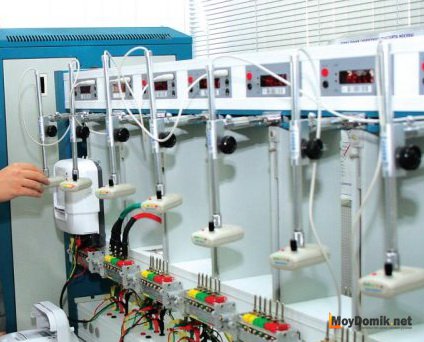
Which electric meter to choose - consumer reviews
On one forum in April 2013, there is a conversation about choosing a counter. The energy supply organization of St. Petersburg is forcing the forum member to replace the "grandfather", who has been in operation for n-th number of decades, with a new one. The forum member asks:
People! Which counter to choose?
Gives possible options, where 7 pcs. - St. Petersburg electric meters, 2 pcs. - Energomer meters.
The guy from Petrozavodsk unambiguously advises Energomer, referring to the fact that working in a sales company, he has extensive experience in selling electricity meters, and he also purchased an electric meter from the above company a year ago, and he believes that he made the right decision. Although he still prefers Mercury.
At the same forum, it is also about the fact that locally, in particular, in St. Petersburg, energy supply companies are trying to “introduce” devices from local manufacturers, obviously being in collusion with them.
In the following articles, we will try to consider some electric meters from other manufacturers, as well as try to choose certain brands that are most suitable for installation.





